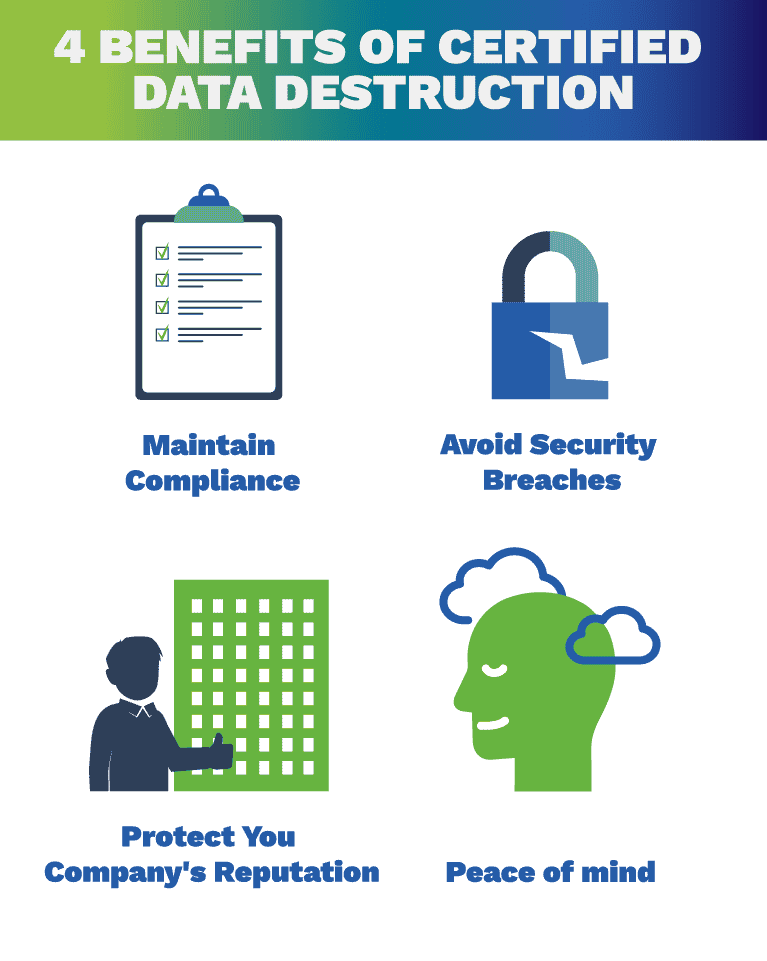Why Data Destruction is an Essential Component of Comprehensive Cyber Security
Why Data Destruction is an Essential Component of Comprehensive Cyber Security
Blog Article
Discovering the Importance of Information Destruction in the Context of Computer System Protection Providers and Protecting Confidential Information
In a period where information breaches are progressively common, the importance of effective information devastation can not be overemphasized. Organizations needs to embrace strict steps to ensure that delicate details is not just safeguarded during its lifecycle but additionally emphatically removed when no longer necessary. The techniques employed for information elimination, combined with compliance to legal criteria, play a crucial function in maintaining discretion and trust fund. The effects of these methods expand beyond mere conformity, influencing a firm's track record and operational honesty in the digital industry. What techniques can companies implement to boost their data devastation protocols?
Comprehending Information Destruction
Data devastation is a crucial part of computer system safety and security that includes the irreversible removal of data from storage gadgets to stop unapproved gain access to and possible data breaches. In an increasingly digital landscape, companies deal with enhanced threats associated with sensitive information being incorrectly accessed or made use of. Efficient information damage safeguards versus these dangers, making certain that private dataâEUR" such as customer information, intellectual residential or commercial property, and monetary recordsâEUR" can not be recuperated after disposal.
Comprehending the value of information destruction expands past plain conformity with lawful and governing structures; it is essential for maintaining organizational integrity and trust fund. When information is poorly taken care of or improperly damaged, the repercussions can be serious, including financial loss, reputational damage, and lawful obligations.

Techniques of Information Elimination

One prevalent technique is data wiping, which entails overwriting existing information with random patterns multiple times. This strategy provides the original data irretrievable, making it a preferred selection for companies looking for to shield personal information.
Another method is degaussing, which uses a powerful electromagnetic field to disrupt the magnetic domains on storage space tools, effectively erasing the data. This approach is particularly effective for magnetic media however is not appropriate to solid-state drives.
Physical damage is one more durable technique, squashing or entailing the shredding of storage space devices. This technique assurances that data recovery is basically difficult, making it suitable for extremely sensitive details.
Last but not least, security can work as a complementary approach to information elimination. By encrypting information before deletion, companies can include an extra layer of safety and security, ensuring that also if remnants are recovered, they continue to be hard to reach without the decryption secret. Each method needs to be selected based on the degree of data level of sensitivity and the particular security needs of the organization.
Legal Conformity and Data Protection
Organizations need to navigate an intricate landscape of legal needs associated with information safety and security, specifically after executing approaches of data obliteration. Different regulations, such as the General Information Protection Guideline (GDPR) and the Health Insurance Coverage Transportability and Liability Act (HIPAA), enforce rigid standards on how companies must dispose and manage of delicate data. Failure to adhere to these regulations can cause substantial legal consequences, consisting of significant fines and reputational damage.
Information devastation procedures must be thoroughly recorded to show compliance with appropriate legislations and criteria. This documents not just serves as proof of adherence to legal responsibilities however additionally highlights a dedication to safeguarding sensitive information. Organizations ought to likewise develop clear plans pertaining to information retention and devastation timelines, ensuring that data is not held longer than required.

In addition, normal audits and analyses of data damage practices are important to maintain compliance and adjust to progressing legal structures (data destruction). By proactively dealing with legal needs, companies can reduce risks connected with information breaches and demonstrate their dedication to information safety and security. Ultimately, focusing on legal compliance in information damage processes is not simply a regulative obligation, but a fundamental facet of a durable data protection method
Effect on Business Online Reputation
The track record of a company can be dramatically affected by its approach to information destruction and monitoring. In today's digital landscape, where information violations can happen anytime, the failure to appropriately throw away sensitive info can lead to serious repercussions. Organizations that inadequately take care of data devastation risk subjecting confidential client details, which not only breaches personal privacy legislations yet also wears down trust fund amongst clients and stakeholders.
A ruined reputation can lead to lowered customer loyalty, as customers come to be hesitant to engage with a service that has actually demonstrated carelessness in shielding their data. Negative promotion surrounding an information violation can have a long-term effect, as potential customers might be discouraged by the viewed absence of safety. This can bring about a straight decrease in revenue and find market share.
Moreover, companies that prioritize data destruction as part of their safety method can improve their online reputation by showcasing their dedication to guarding delicate details. By adopting stringent data management techniques, companies can not just alleviate threats yet likewise position themselves as credible entities in their respective industries, thereby reinforcing their total brand name image.

Best Practices for Secure Disposal
Implementing ideal methods for secure disposal of data is essential for alleviating threats related to information breaches and making certain conformity with personal privacy guidelines. Organizations needs to take on an extensive data disposal plan that describes treatments for both physical and digital information destruction.
For physical information storage tools, such as hard disks, shredding or degaussing is recommended to prevent information recovery. In addition, organizations need to preserve a chain of custodianship documentation throughout the disposal process, guaranteeing accountability and traceability of disposed things.
For electronic data, using software that sticks to sector standards for data wiping is vital. This software program must overwrite existing data multiple times, more tips here making recuperation essentially impossible. It is likewise important to confirm the performance of the data damage procedure through audits or third-party evaluations.
Training workers on safe and secure disposal methods includes another layer of safety and security, as human mistake can often result in information direct exposure. Frequently upgrading and evaluating disposal policies makes sure placement with advancing policies and technical advancements. By executing these ideal methods, companies can substantially lower the risk of unauthorized data gain access to and enhance their total data defense approach.
Conclusion
In final thought, information destruction is an essential facet of computer protection solutions that makes more info here sure the protection of private details from unauthorized gain access to. Implementing effective approaches of data eradication, adhering to lawful conformity, and acknowledging the influence on company credibility are vital elements of an extensive data security approach. By embracing best practices for safe disposal, companies can promote count on with clients and guard sensitive data, ultimately adding to a much more safe and secure digital landscape.
In an era where information breaches are progressively usual, the relevance of reliable data devastation can not be overemphasized.Data damage is an important element of computer system safety that involves the irreversible elimination of information from storage gadgets to prevent unapproved access and possible data violations. Organizations should likewise develop clear policies pertaining to data retention and devastation timelines, guaranteeing that information is not held longer than necessary.
By proactively attending to lawful demands, companies can mitigate dangers linked with data violations and show their commitment to data protection (data destruction). Ultimately, prioritizing lawful conformity in data damage procedures is not just a regulative responsibility, but a fundamental element of a durable data safety and security strategy
Report this page